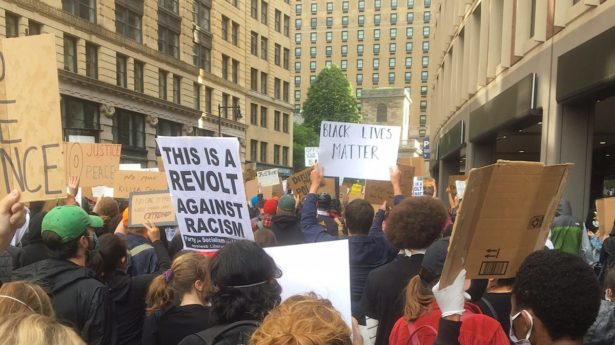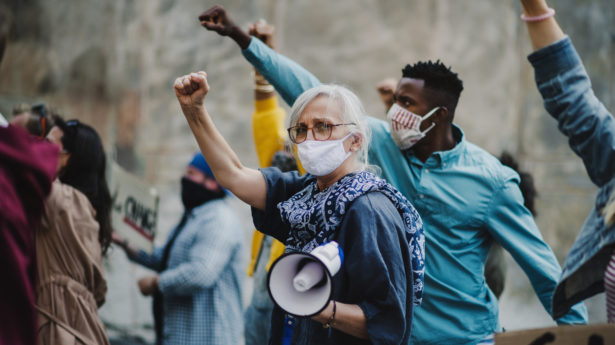The Unitarian Universalist Service Committee advances human rights through grassroots collaborations.
3 Toxic Narratives We Cannot Accept After the Buffalo Shooting

By Mike Givens on May 16, 2022
The three days of May 13, 14 and 15 were particularly violent with several mass shootings across the United States. In Harris County, Texas, an altercation at a flea market led to a shooting that took the lives of two and seriously injured three. More than 1,100 miles north in Milwaukee, Wisconsin, 21 people were shot in three separate incidents in the downtown area.
In California, the media is reporting that at least one person is dead and five other people were injured in a shooting at a church in Laguna Woods. As of this writing, there is currently no known motive for the shooting, which reportedly was committed by an older adult with two handguns.
In Buffalo, New York, an 18-year-old White man reportedly walked into a Tops Market and proceeded to shoot 13 people; 11 of the victims were Black while two were White. Ten people were killed and it was clear that the crime was racially motivated.
While all of these shootings are devastating, the Buffalo shooting was particularly egregious given reports that the shooter is a White supremacist who authored a 180-page manifesto spewing hatred toward people of color, Jewish people, and immigrants.
In the wake of a major incident of gun violence in the United States, there are always intense conversations about gun control, victimhood, mental health, and racial dynamics. The Buffalo shooting is no different. However, this shooting has reiterated—or introduced—three harmful narratives that we must be diligent in dismantling.
Narrative 1: Thoughts and prayers are sufficient during—and after—a crisis
It’s quite common for politicians and other public servants to issue statements of condolence after a mass shooting. While the sentiment is welcome, the lack of action behind it is not.
“Thoughts and prayers” are routinely showered on victims and families, but rarely do we see decision makers enacting laws and policies that address gun violence. As the years have progressed, mass shootings have become more prevalent. And in the wake of the death and injury they cause, there is often little comfort in the bland, non-committal thoughts shared by people with the power to introduce change. Sadness and sorrow are poor substitutes for decisive action.
This will not be the last mass shooting in the United States, but it could spark a constructive conversation—and actual change. We are capable of discerning ways to best protect our human rights while also respecting the 2nd Amendment. The two ideas aren’t mutually exclusive.
Narrative 2: The “Great Replacement” is causing the White population of the United States to “dwindle”
Payton Gendron, the suspect in the Buffalo shooting, wrote a detailed manifesto, a nearly 200-page document memorializing his racist views.
Central to this document was the contention that White Americans are being “replaced” by people of color. And, according to Gendron, Jewish people are the cause.
There will never be a shortage of people who want to blame their unhappiness and dissatisfaction on others. However, wild, unsubstantiated, and racist theories that refer to the fictitious genocide of White people simply because more people of color are born in or enter the United States is not only false, but highly problematic.
There is no conspiracy when it comes to people of color becoming more prevalent in the United States and demonizing an entire group of people to rationalize hate, violence and abusive treatment is morally repugnant and indefensible.
Narrative 3: Violence is random, not systemic
Beware the bad actors who refuse to see patterns and connections. A common refrain for many is that guns don’t kill people; people kill people. The intellectual laziness that requires so many to blind themselves to how easy it is to procure dangerous weapons should have all of us concerned.
Gun violence is random and only caused by people who are mentally ill, say those who want to keep gun laws as lax as possible. But it’s not; Gendron is just one of many people who buy into the racist and harmful stereotypes that dehumanize people of color. And when hatred and bigotry are that palpable, it’s no surprise that we continue to see these shootings.
Education, housing, the economy, and all of the many systems and institutions we rely on are rife with implicit bias, blatant prejudice and racism, and a disposition that disadvantages people of color and other communities who face oppression.
Rep. Elise Stefanik of New York built her campaign and legislative career echoing the contentions of the “Great Replacement” theory. Her anti-immigrant stance has often drawn her into public discussions around White America being attacked.
And it doesn’t end with Stefanik. Wendy Rogers, an Arizona state senator known for her anti-immigrant views, did her best to distance herself from Gendron and even accused him of being a tool used by leftists. With legislators like this in positions of power, people who actively stoke intolerance, we know why we see so much hate being actualized in the form of these shootings.
The political hot potato that inevitably follows such a high-profile tragedy often deflects from the core truth at the heart of our gun laws: The United States is a nation with a serious problem when it comes to common sense legislation. It should come as no surprise to any of us that we routinely see violence like this when we’re routinely fed violence like this by the systems and institutions we rely on.
We experience the national tragedy of gun violence over and over and over again and yet we never get beyond thoughts and prayers when it’s time to actually do something. We never notice that the systems and institutions that populate our lives are often the bullet loaded into the gun that will eventually fire at some innocent person.
Regardless of the narrative that plays out after a mass shooting, it’s pivotal that we keep one value at the top of our minds and hearts: We all have the human right to safety and if there exists an impediment to that right—like guns—we have a moral obligation to balance personal freedom and personal safety.
Photo Credit: iStock—Jacek_Sopotnicki

